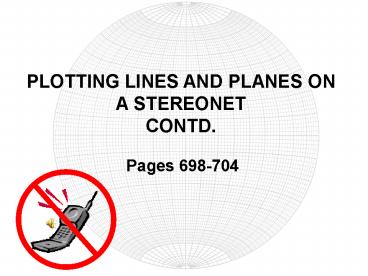PLOTTING LINES AND PLANES ON A STEREONET CONTD. PowerPoint PPT Presentation
1 / 15
Title: PLOTTING LINES AND PLANES ON A STEREONET CONTD.
1
PLOTTING LINES AND PLANES ON A STEREONET CONTD.
Pages 698-704
2
Plotting a plane by its dip and dip direction on
a stereonet
- Dip inclination of the line of greatest slope
on an inclined plane - Refers to TRUE DIP as opposed to APPARENT DIP of
a plane - 0 apparent dip lttrue dip
- Dip direction is ALWAYS perpendicular to strike
direction - The dip and dip direction of an inclined plane
completely defines its attitude - Plotted the same way as lines
3
Plotting dip lines of planes on stereonet (lab
3 contd.)
Plot the dip lines to the planes with the given
attitude
Dip/dip direction 38NE 57SW 43SE 65SW 23N 71NW
- Strike
- 342
- N35W
- S27W
- 132
- 278
- N25E
4
Plotting dip lines of planes on stereonet
Dip amount 67 58 59 26 90 58 23
- Dip direction
- 357.5
- 17.5
- 282.5
- 112.5
- 77.5
- 330.5
- 55.5
Data from Rock-fall Hazard Assessment of the
Aspen Forest Trail, Navajo National Monument,
Arizona U. S. Geological Survey Open-file Report
00-305, 2000 http//pubs.usgs.gov/of/2000/ofr-00-0
305/
5
Constructing Markland test plots using stereonets
- On the tracing paper where you plotted the dip
lines, draw a circle representing a cone making
60 angle around a vertical axis. This circle
represents all planes dipping 30 - Similarly draw a circle representing all planes
dipping 35 and 60. The 35 circle represents
all planes at the critical friction angle
(anything dipping more than that has the
potential for failure)
6
Whats the point?
Data from Rock-fall Hazard Assessment of the
Aspen Forest Trail, Navajo National Monument,
Arizona U. S. Geological Survey Open-file Report
00-305, 2000 http//pubs.usgs.gov/of/2000/ofr-00-0
305/
7
Markland test plots using stereonets
- On the same tracing paper plot
- Slope face 1 as a great circle (dip direction
003, dip angle 65 - If a plane has dip value greater than the
friction angle and less than the slope angle,
then sliding along the plane is possible. Such
planes will fall within the critical zone bound
by the intersection of the friction circle and
the slope face great circle. - Determine the potential for rockfall hazard based
on your plot
8
Interpretation Rockfall or no rockfall?
Data from Rock-fall Hazard Assessment of the
Aspen Forest Trail, Navajo National Monument,
Arizona U. S. Geological Survey Open-file Report
00-305, 2000 http//pubs.usgs.gov/of/2000/ofr-00-0
305/
9
Interpretation Rockfall or no rockfall?
Data from Rock-fall Hazard Assessment of the
Aspen Forest Trail, Navajo National Monument,
Arizona U. S. Geological Survey Open-file Report
00-305, 2000 http//pubs.usgs.gov/of/2000/ofr-00-0
305/
10
Interpretation Rockfall or no rockfall?
Data from Rock-fall Hazard Assessment of the
Aspen Forest Trail, Navajo National Monument,
Arizona U. S. Geological Survey Open-file Report
00-305, 2000 http//pubs.usgs.gov/of/2000/ofr-00-0
305/
11
Steps for determining the orientation of the line
of intersection of two planes (page 703)
- We will use the example given in the text and
determine the trend and plunge of the line of
intersection of the planes N49E/42SE and
N10W/65NE. - Plot both planes as great circles and label them.
- The line of intersection of those two planes is
the point where the great circles meet. Label
this point.
12
- Rotate the tracing paper in such a way that this
point lies on the NS straight line. Draw a
straight line from this point along the NS
straight line all the way to the outside circle.
This line represents the vertical plane passing
through the line of intersection and will give
you the TREND for that line. - Count off the small circle intercepts between
this point and the equatorial plane (the outside
circle) along the NS straight line. This will
give you the PLUNGE AMOUNT for the line of
intersection.
13
- Now rotate the tracing paper back to the original
position (the point marked NORTH on the tracing
paper coinciding with the top of the stereonet).
Determine where the straight line segment you
drew for step 3 intersects the equatorial plane.
This is the TREND for the line of intersection.
14
Identify the line of intersection of the
following planes
Dip/dip direction 38NE 43SE 57SW 23N 65SW 71NW
- Strike
- 342
- S27W
- N35W
- 278
- 132
- N25E
Pair 1
Pair 2
Pair 3
15
Identify the line of intersection of the
following planes
Dip amount 58 26 23 59 67 58
- Dip direction
- 17.5
- 112.5
- 55.5
- 282.5
- 357.5
- 330.5
Pair 1
Pair 2
Pair 3

